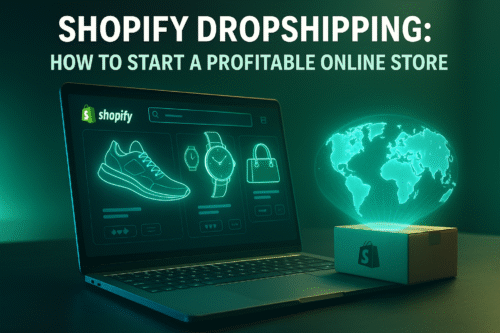Building a profitable Shopify store is more than just launching a website — it’s about crafting a seamless shopping experience, strategic marketing, and long-term customer trust. As eCommerce continues to grow rapidly, understanding how to optimize every element of your Shopify store is essential to maximize conversions and revenue.
In this guide, we’ll walk you through the top 10 proven strategies to turn your Shopify store into a powerful, profit-generating machine.
1. Choose a Profitable Niche with High Demand
Before you even start designing your store, researching a profitable niche is the foundation of success. Your niche should combine high demand, low competition, and strong profitability.
Use tools like Google Trends, SEMRush, or Ahrefs to analyze keywords, trends, and search volume. Focus on niches that solve a problem, evoke passion, or fill a market gap — for instance, eco-friendly products, wellness items, or pet accessories.
Pro tip: Avoid overly saturated markets. Instead, specialize — for example, instead of “fitness gear,” go for “home workout resistance bands.”
2. Build a Visually Appealing and Fast-Loading Shopify Theme
Your store design defines first impressions. Shopify offers many themes, but to ensure profitability, select a responsive, mobile-optimized theme that loads quickly and highlights your products effectively.
Choose themes like Dawn, Booster, or Debutify that are customizable and conversion-optimized.
- Keep your design clean and minimalistic.
- Use high-quality product images.
- Ensure fast load times (under 3 seconds).
- Test across devices for responsiveness.
A smooth, visually appealing site builds trust and encourages visitors to make a purchase.
3. Craft Compelling Product Descriptions
A great product description sells benefits, not just features. Each product page should be written to persuade and inform.
Follow this structure:
- Start with a strong opening sentence that grabs attention.
- Highlight unique benefits and solutions your product provides.
- Use bullet points for clarity.
- End with a call to action like “Order now” or “Limited stock available!”
Use SEO-optimized keywords naturally throughout the copy to boost organic visibility. Remember, emotionally driven and benefit-focused content converts far better than technical descriptions alone.
4. Optimize Product Images for Conversion
Visuals drive confidence and engagement. Use high-resolution, consistent, and lifestyle-oriented images that help customers imagine using your products.
Include multiple angles, zoom features, and even videos if possible. Optimize image sizes without compromising quality to improve page load speed — a crucial ranking and conversion factor.
Bonus Tip: Add alt text with relevant keywords to every image. This boosts SEO and helps visually impaired users understand your content better.
5. Implement SEO Best Practices for Shopify
Shopify’s SEO capabilities can make your store rank higher in search engines if properly optimized.
Key areas to focus on:
- Optimize page titles and meta descriptions with target keywords.
- Use clean URL structures (e.g., /collections/handmade-jewelry).
- Add internal links between related products and blog posts.
- Submit your sitemap to Google Search Console.
- Write keyword-rich alt tags for all media files.
Consistency in SEO optimization will lead to sustainable organic traffic growth and higher conversions over time.
6. Utilize Shopify Apps to Automate and Optimize
Shopify’s App Store offers thousands of integrations to streamline business operations. The key is selecting tools that enhance performance without bloating your site.
Essential apps include:
- Klaviyo or Omnisend for email marketing automation.
- Yotpo for product reviews.
- Plug in SEO to fix on-page issues.
- ReConvert Upsell & Cross Sell to increase order value.
- Loox for customer photo reviews.
Automation reduces manual work, increases retention, and drives repeat purchases — essential for profitability.
7. Drive Traffic with Targeted Marketing Campaigns
No matter how beautiful your store is, it won’t generate sales without consistent traffic. Focus on building both paid and organic marketing strategies.
- Use Facebook and Instagram ads to target your audience precisely.
- Leverage Google Shopping Ads for high-intent buyers.
- Start a content marketing strategy with blogs, videos, and how-to guides.
- Collaborate with influencers and micro-influencers in your niche.
- Build an email marketing funnel for retention.
A diversified traffic approach ensures your sales don’t rely on one channel alone.
8. Build Trust with Social Proof and Reviews
Consumers trust other customers more than brands. Social proof builds credibility and reduces hesitation before checkout.
- Display customer testimonials and photo reviews.
- Showcase trust badges, secure payment icons, and return guarantees.
- Highlight real user-generated content (UGC) from social media.
Transparency and trustworthiness lead to higher conversion rates and returning customers.
9. Simplify the Checkout Process
A complex checkout is one of the biggest causes of cart abandonment. Make sure your checkout flow is smooth, fast, and distraction-free.
- Offer guest checkout options.
- Include multiple payment methods like UPI, PayPal, and cards.
- Use auto-fill for returning users.
- Display clear shipping costs and delivery times upfront.
The simpler and faster your checkout, the fewer customers you lose at the last step.
10. Measure, Analyze, and Continuously Improve
Success in eCommerce is data-driven. Regularly analyze performance metrics such as:
- Conversion rate
- Average order value (AOV)
- Customer lifetime value (CLV)
- Cart abandonment rate
Use Shopify Analytics, Google Analytics, and Hotjar to track user behavior. Identify friction points, test new strategies, and refine what works best.
Continuous improvement ensures long-term profitability and growth.
Bonus Tip: Build a Strong Brand Identity
While optimizing and marketing are vital, brand loyalty is what sustains profits. Invest time in defining your brand story, voice, and values.
Your Shopify store should represent more than products — it should convey trust, personality, and connection. From your logo to your customer support tone, consistency across all touchpoints turns buyers into brand advocates.
Final Thoughts
Building a profitable Shopify store isn’t an overnight success — it’s the result of strategy, optimization, and consistency. By focusing on the right niche, user experience, SEO, and marketing efforts, you can turn your Shopify store into a long-term revenue-generating asset.
Follow Us | Our Services | Contact Us | Linkedin | Instagram







